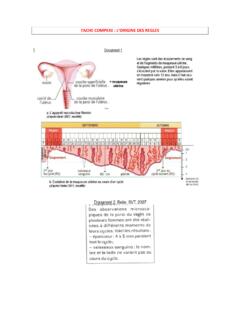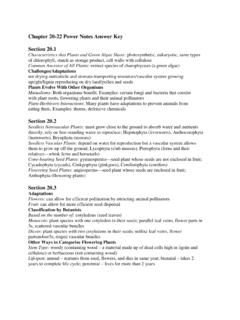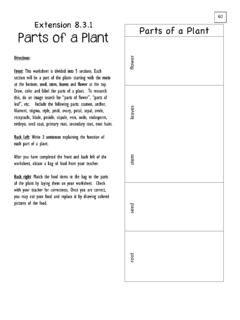Transcription of UNIT – VI CHAPTER 1. REPRODUCTION IN ORGANISMS …
1 UNIT VI. CHAPTER 1. REPRODUCTION IN ORGANISMS . What is REPRODUCTION ? REPRODUCTION is the biological process in which an individual gives rise to an offspring similar to itself. Types of REPRODUCTION : ASEXUAL REPRODUCTON. SEXUAL REPRODUCTION . Based on whether there is one or two ORGANISMS taking part in process of REPRODUCTION Asexual REPRODUCTION : 1. Usually followed by orgs. with relatively simpler organizations. 2. Offsprings produced by single parent. 3. With/without involvement of gamete formation. 4. Offsprings produced are genetically and morphologically similar to each other and to the parent, they are clones. Modes of asexual REPRODUCTION : fission Cell division of parent cell into 2 daughter cells. Amoeba, Paramecium Parent cell divides to form large cell and small cell, called bud, attached to the large cell; the bud gets separated and grows into an adult.
2 , Yeast In fungi and algae specialized asexual reproductive units are formed Zoospores in many algae and certain aquatic fungi, Conidia (Penicillium), Buds (Hydra), Gemmules (Sponge). In higher plants, vegetative propagation is followed using units such as rhizome, sucker, offset, bulb, tuber etc. known as vegetative propagules. Examples of Vegetative Propagation: WATER HYACINTH (Terror of Bengal). One of the most invasive weeds Grows wherever there is standing water Drains oxygen from water- leads to death of fishes. Introduced in India because of its pretty flowers & shape of leaves Vegetative propagation occurs at a phenomenal rate II SEXUAL REPRODUCTION : Involves formation of male and female gamete by two individuals of the opposite sex. Offspring produced by fusion of male and female gametes not identical to each other or to the parents.
3 All sexually reproducing ORGANISMS share a similar pattern of REPRODUCTION . Different phases in sexual REPRODUCTION : PHASE. Period of growth and maturity of an organism before it can reproduce sexually. PHASE. Period in which org. is capable of reproducing sexually Easily seen in higher plants when they come to flower. Some plants flower seasonally & some thruout the year Few plants exhibit unusual flowering phenomenon For 1. Bamboo species flower only once in their lifetime. 2. Srobilanthus kunthiana (neelakurinji). found in hilly areas of Kerala, Karnataka & Tamil Nadu, flower once in 12 years the latest being in September 2006. In animals sexual REPRODUCTION is usually seasonal In placental mammals there is occurrence of cyclical changes in the activities of ovaries &.
4 Accessory ducts as well as hormones In non primate mammals like dogs, rats etc these cyclical changes during REPRODUCTION is called oestrus cycle. In primate mammals like apes & humans, these cycles are called menstrual cycles. PHASE. End of reproductive phase. Old age ultimately leads to death EVENTS IN SEXUAL REPRODUCTION : EVENTS. PRE- POST. FERTILISATION. FERTILISATION FERTILISATION. GAMETOGENESIS GAMETE TRANSFER. 1. PRE-FERTILIZATION EVENTS: a)GAMETOGENESIS. The gametes are usually haploid Gametes called homogametes / isogametes when both have same appearance When gametes are different, they are called heterogametes; male gamete known as antherozoid /sperm, female is called ovum Bisexual orgs. called as homothallic /monoecious whereas unisexual orgs. called heterothallic /.
5 Dioecious. b) GAMETE TRANSFER. In most of the orgs., male gametes are motile & female gametes are stationary. In algae, bryophytes & pteridophytes water is the medium for gamete transfer Pollination is the method of gamete transfer in higher plants as pollen grains are carriers of male gametes 2. SYNGAMY / FERTILIZATION: Syngamy results in formation of a diploid zygote In certain animals, female gamete develops into the adult organism without fertilization; such a process is called parthenogenesis - seen in rotifers, lizards turkeys etc. Fertilisation may be external or internal EXTERNAL FERTILIZATION INTERNAL FERTILIZATION. Syngamy occurs outside the body of the organism Syngamy occurs inside the body of the organism Large number of gametes are released in the Number of ova produced are less, but large surrounding medium.
6 Ex. Bony fishes and number of male gametes are released and they Amphibians. travel towards the ovum. Ex. Birds and Mammals. 3. POST FERTILIZATION: Events in sexual REPRODUCTION after the formation of zygote Zygote vital link that ensures continuity of species b/w orgs. Of one generation & the next Development of zygote depends on -the type of life cycle of the ORGANISMS . -the environment it is exposed to. Zygote develops into embryo Embryogenesis involves: - cell division to increase the no. of cells - cell differentiation for the formation of different kinds of tissues Based on whether the dev. of zygote occurs inside or outside the body of the female parent, animals are categorized into oviparous and viviparous. OVIPAROUS VIVIPAROUS. These animals lay eggs.
7 These animals give birth to young ones The fertilized eggs have a calcareous shell Embryo protected inside the mother's body. to protect them from harsh environment. In flowering plants the zygote formed inside the ovule; zygote develops into embryo after which the ovule becomes the seed and ovary becomes the fruit. **. CHAPTER 2 - SEXUAL REPRODUCTION IN FLOWERING PLANTS. FLOWER - the fascinating organs of angiosperms Flower is the reproductive organ of angiosperms. It consist of :- 1. Calyx 2. Corolla 3. Androecium 4. Gynoecium PRE- FERTILISATION STRUCTURES AND EVENTS. Hormonal and structural changes initiated leading to differentiation and development of floral primordium. Inflorescences are formed which bear floral buds and then flowers Androecium and gynaecium differentiate and develop.
8 STAMEN. Stamen consist of 1. Anther terminal bilobed structure Filament long slender stalk. Proximal end of the filament is attached to the thalamus or petal. STRUCTURE OF ANTHER. Anther has 2 lobe (bilobed). Each lobe consist of 2 theca. Hence it is dithecous Anther is a tetragonal structure which consist of 4 micro sporangia located 2 in each lobe. Microsporangium develop into pollen sacs. Pollen sacs run longitudinally and contain pollen grains. STRUCTURE OF MICROSPOANGIUM. A typical microsporangium appears circular in outline. It is surrounded by 4 walls. 1. Epidermis - protects and help in dehiscence of anther. 2. Endothecium 3. Middle layers 4. Tapetum - nourishes the developing pollen grain SPOROGENOUS TISSUE. Compactly arranged homogenous cells which are present at centre of each microsporangium when the anther is young MICROSPOROGENESIS.
9 Process of formation of microspores from pollen mother cell through meiosis. The cells of the sporogenous tissue/microspore mother cell (2n) meiotically divide to form microspores which are arranged in a cluster of 4 cells called MICROSPORE TETRAD. When the anther matures and dehydrates, the microspore dissociate from each other and develop into pollen grains Thousands of pollen grains formed inside a microsporangium- released with dehiscence of anther. POLLEN GRAINS. Pollen grains are male gametophyte- spherical in shape. STRUCTURE OF POLLEN GRAIN. Pollen grains are made of 2 layered Wall, 1. EXINE - Made of sporopollenin- most resistant organic matter known, 2. INTINE. -Thin and continuous layer -made of cellulose and pectin pores -apertures on exine where sporopollenin is absent -forms pollen tube.
10 4. A plasma membrane surrounds cytoplasm of pollen grain. MATURE POLLEN. A mature pollen consist of 2 cells VEGETATIVE CELL. Bigger Abundant food reserve Large irregular nucleus Responsible for the development of pollen grain GENERATIVE CELL. Small Involved in syngamy Dense cytoplasm and nucleus. Pollen grains cause allergy and bronchial afflictions Leading to chronic respiratory disorders like asthma, bronchitis Eg :- Parthenium (carrot grass). POLLEN PRODUCTS. Rich in nutrient. Pollen tablets and syrup - food supplements - claims to increase performance of athletes and race horse. Period of viability Once shed the pollen grains have to land on the stigma before they lose viability if they have to bring about fertilisation. Period of viability depends on temperature and humidity eg:-cereals 20 mins and members of rosaceae, leguminoseae, solanaceae take months.







